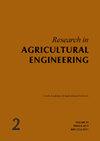Thin layer drying characteristics of alligator pepper, ginger and turmeric
Q3 Agricultural and Biological Sciences
引用次数: 0
Abstract
: The delightful pungency, aromatic compounds and phytochemicals in some spices make them indispensable in local food systems and native medicine, hence, driving a robust market in many parts of the world. The understanding of their drying characteristics is very important for processing and adding value, and a thin layer drying study is a pro-ven method for achieving this. In this study, changes in the moisture content, moisture ratio, drying rate and effective diffusivity of alligator peppers, ginger and turmeric were investigated at three drying temperatures 50, 60, and 70 °C following standard procedures. Five models were proposed to simulate the drying process. Non-linear regression was used to establish the coefficient of determination ( R 2 ), sum of square error (SSE) and root mean square error (RMSE) for each model to determine the model of the best fit. The Page model gave the best fit for ginger while the logarithmic model was best fitted for alligator peppers and turmeric. The effective diffusivity ranged from 1.79–3.08 × 10 –9 , 8.44–9.74 × 10 –9 , and 4.06–6.49 × 10 –9 m 2 ·s –1 for alligator peppers, ginger and turmeric, respectively. The activation energy ranged from 16.5–22 kJ·mol –1 ·K –1 for the three spices. These findings promise improvement in the drying, processing and handling of spices, thereby boosting the obtainable income from the value chain.鳄椒、姜、姜黄的薄层干燥特性
一些香料中令人愉悦的辛辣、芳香化合物和植物化学物质使它们成为当地食品系统和当地药物中不可或缺的一部分,因此在世界许多地方推动了一个强劲的市场。了解它们的干燥特性对加工和增值非常重要,而薄层干燥研究是实现这一目标的有效方法。本文研究了鳄椒、生姜和姜黄在50、60和70℃三种干燥温度下水分含量、水分比、干燥速率和有效扩散率的变化。提出了5种模型来模拟干燥过程。采用非线性回归建立各模型的决定系数(r2)、误差平方和(SSE)和均方根误差(RMSE),确定最优拟合模型。佩奇模型最适合生姜,对数模型最适合鳄鱼椒和姜黄。短吻鳄椒、姜和姜黄的有效扩散系数分别为1.79 ~ 3.08 × 10 -9、8.44 ~ 9.74 × 10 -9和4.06 ~ 6.49 × 10 -9 m2·s -1。三种香料的活化能范围为16.5 ~ 22 kJ·mol -1·K -1。这些发现有望改善香料的干燥、加工和处理,从而提高价值链的可获得收入。
本文章由计算机程序翻译,如有差异,请以英文原文为准。
求助全文
约1分钟内获得全文
求助全文
来源期刊

Research in Agricultural Engineering
Engineering, agriculture-
CiteScore
1.40
自引率
0.00%
发文量
21
审稿时长
24 weeks
期刊介绍:
Original scientific papers, short communications, information, and studies covering all areas of agricultural engineering, agricultural technology, processing of agricultural products, countryside buildings and related problems from ecology, energetics, economy, ergonomy and applied physics and chemistry. Papers are published in English.
 求助内容:
求助内容: 应助结果提醒方式:
应助结果提醒方式:


